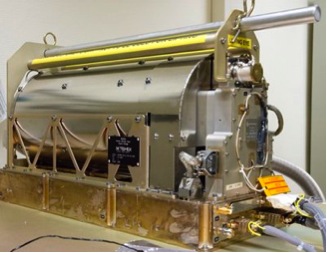Hydrogen masers
Unlike thermal beam or cold atom clocks in which atoms pass through the interaction cavity, hydrogen masers use atoms confined in a storage balloon inserted into a resonant microwave cavity. The storage balloon inner walls are covered with a Teflon coating so that the hydrogen atoms quantum state is little disturbed during the multiple rebounds of the atoms on the walls.
Atoms emit by stimulated radiation emission directly at their resonance frequency (1.4 GHz for hydrogen). If the losses in the cavity are low enough, the system can oscillate spontaneously and generate a very high frequency stability signal. It is then an “active” hydrogen maser. When the losses in the cavity are too high, which is the case for more compact systems (inclusion of a dielectric in the cavity or use of other resonant cavity geometries, of the magnetron type), the system cannot oscillate by itself and the maser operation then becomes “passive”.
Active hydrogen masers have better mid-term frequency stabilities than thermal beam clocks. This property makes them suitable for uses such as the design of high-quality atomic timescales, very long baseline interferometry (VLBI) but also fundamental physics tests such as the direct gravitational shift measurement in the Gravity Probe A mission which embedded an active maser in a rocket. An active space maser is also being developed in Switzerland as part of the ACES space mission to be installed in addition to the PHARAO clock.
As far as passive hydrogen masers are concerned, they are used as a reference time in the European positioning system GALILEO satellites, in addition to rubidium clocks. Their stability, less than 10-12 t-1/2, is better than that of vapor cell rubidium clocks, in the short and medium term.

Original developments of cryogenic masers using gallery modes have also been carried out at the FEMTO-ST laboratory.
